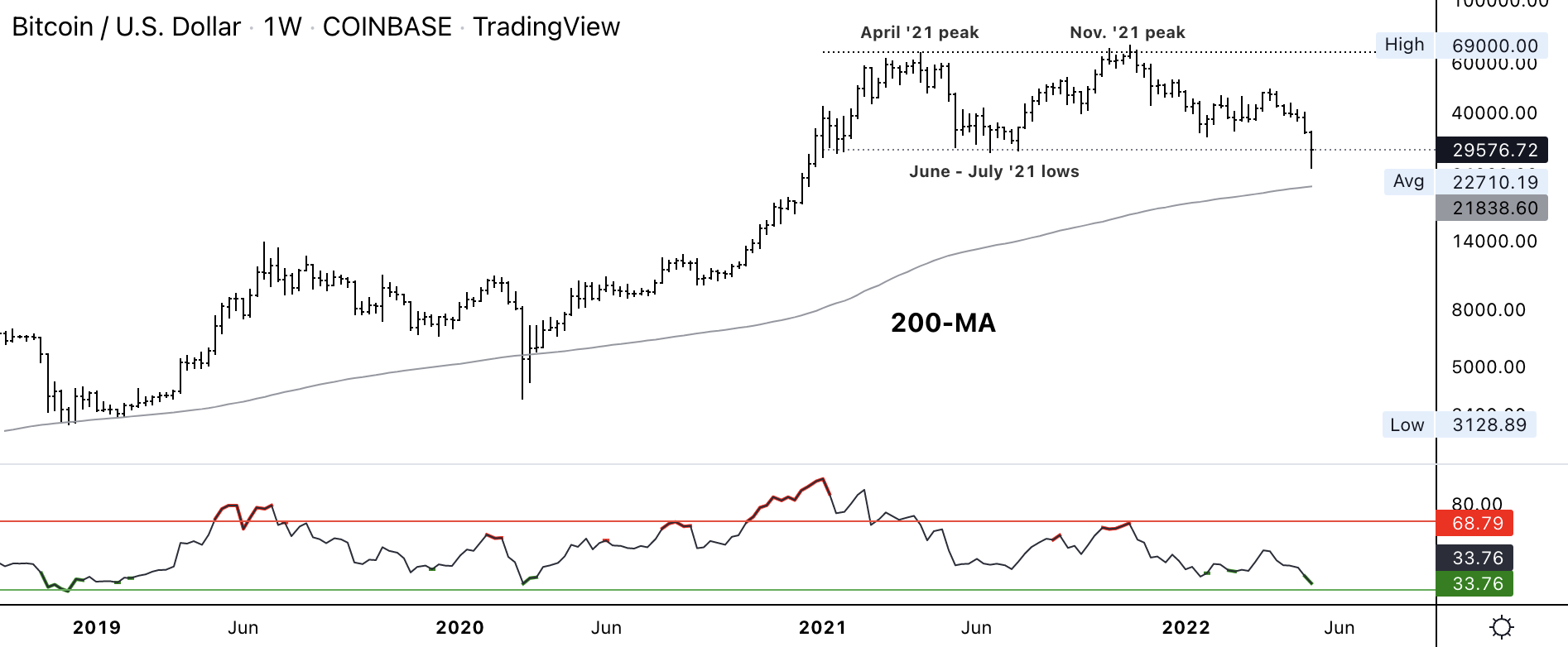Terraform Labs, the Singapore-registered company behind the Terra protocol, doesn’t have a permanent office in the city-state; most major cryptos spent Sunday in the green.
Good morning. Here’s what’s happening:
Prices: Bitcoin mounts a small Sunday comeback.
Insights: Crypto companies may face more scrutiny in Singapore.
Technician's take: BTC is on track for its first consecutive seven-week decline.
Prices
Bitcoin (BTC): $31,122 +3.5%
Ether (ETH): $2,139 +4.5%
Biggest Gainers
| Asset | Ticker | Returns | DACS Sector |
|---|---|---|---|
| Cosmos | ATOM | +14.1% | Smart Contract Platform |
| Solana | SOL | +13.6% | Smart Contract Platform |
| Cardano | ADA | +12.7% | Smart Contract Platform |
Biggest Losers
| Asset | Ticker | Returns | DACS Sector |
|---|---|---|---|
| Bitcoin Cash | BCH | −3.4% | Currency |
Bitcoin rebounds
As comebacks go, it wasn't much. But Bitcoin will take what it can get at this point.
So will other cryptos hammered last week by the toxic mix of geopolitical unrest, rising interest rates, recessionary fears and the implosion of the terraUSD (UST) stablecoin and the LUNA token that backs it.
Bitcoin was recently trading above $31,000, up nearly 6% over the past 24 hours and more than 16% from the $26,600 depths it sank to mid-Friday. "Bitcoin did indeed face downward pressure that saw it losing the $30K support, but it did not fall below the 25K level," Joe DiPasquale, the CEO of crypto fund manager BitBull Capital, wrote to CoinDesk.
Ether, the second largest crypto by market cap, was recently up similarly and changing hands at about $2,100 after earlier in the week dropping below $1,800 for the first time in two months. Most major altcoins spent Sunday well in the green, recovering some of the ground they lost last week as the crypto market cap tumbled by $300 billion. SOL rose more than 10% at one point, although its $55 price was down from over $70 at the start of the week.
ADA, AVAX and AXS posted increases ranging between 9% and 11%. BCH was among the few losers earlier Sunday.
Crypto gains dovetailed with equity markets that finally enjoyed some good news Friday after six straight days of declines. The tech-focused Nasdaq closed up 3.8%, while the S&P 500 and Dow Jones Industrial average rose 2.3% and 1.4%, respectively. Still, the week's economic bad news is unlikely to shake investors from their risk-averse positions of recent months.
On Wednesday, the U.S. Commerce Department announced that consumer prices had risen 8.3% in April, slightly better than the previous month but nevertheless a sign that inflation driving a range of goods and services would linger. Even the once torrid housing market has felt shockwaves as mortgage rates have risen over 5.3%, increasing the difficulty for would-be homeowners to finance their purchases. Investors have been concerned that U.S. central bank hawkishness was inadequate to tame rising prices without throwing the economy into recession.
In an email Friday, Hargreaves Lansdown Senior Investment and Markets Analyst Susannah Streeter highlighted "investor worries over inflation, supply concerns the UST fall, which sent LUNA tumbling to a fraction of a cent. "For now the crypto wild west is taking a breather after reeling from the crash brought on by the collapse of a so-called stablecoin," Streeter wrote, adding: "This latest plunge in the wheel of fortune demonstrates that speculating in cryptocurrencies is extremely high risk and are not suitable for investors who don’t have money they can afford to lose.’’
BitBull's DiPasquale noted that "a near-term bounce" in Bitcoin "is still intact but a proper reversal needs more buying activity." He called last week's low "a decent buying opportunity for long-term exposure," but also warned that "the coming month may bring additional volatility as more concrete steps by the FED to fight inflation come to the fore."
Markets
S&P 500: 4,023 +2.3%
DJIA: 32,196 +1.4%
Nasdaq: 11,805 +3.8%
Gold: $1,811 -0.5%
Insights
Singapore will be eyeing locally registered crypto firms
As the week closed in Asia, LUNA and UST were de-listed from most exchanges as the Terra blockchain was halted for nine hours (currently resumed) and the market seemed to reject a recovery plan.
The question on many people’s minds is, how will token holders be made whole? That’s where things get complicated.
Terraform Labs, the Singapore-registered company behind the Terra protocol, doesn’t have a permanent office. The Singapore address it provides is a registration agent, home to hundreds of Singaporean companies. Its offices are rented co-working spaces worldwide; like many Web 3 startups, there’s no formal headquarters.
The only assets the company has are from the Luna Foundation Guard. This non-profit organization, also registered in Singapore and overseen by Do Kwon, controls the wallets that were to support the UST peg during times of extreme volatility. The majority of these wallets are now empty, with the only thing of value remaining being the approximately $69 million in avalanche token (AVAX).
Singapore’s regulators are aware of the trend of crypto companies using a Singaporean entity to conduct business abroad with no material ties to the country. In April, its Parliament passed a bill into law that included provisions that require domestically registered crypto companies that do business abroad to be licensed primarily for anti-money laundering reasons, but leaves the door open in the future for this to expand.
As the year began, Terra’s LUNA token had a market cap of $33 billion. Its UST stablecoin had a market cap of $10 billion. Now, with Terra blockchain halted, perhaps for good this time, both have a virtual value of $0.
Should there be a legal case made against the companies behind the protocol by the token holders, what sort of assets could be seized? What jurisdiction does the Singapore government have over Do Kwon and co-founder Daniel Shin? On company filings with local authorities, both provide addresses in Singapore but it's unclear if they reside there full time, as Kwon maintains a residence in South Korea, too.
With its lawsuit against the Securities and Exchange Commission (SEC), Terraform Labs and Do Kwon asserted that American regulators don’t have jurisdiction over Kwon, a Korean residing in Singapore. They have no ties to the U.S., so how can they be targeted by regulators? they argued. But they might find themselves dealing with Singapore’s justice system, and while the country has a favorable securities framework compared to the U.S. its courts are known to be otherwise strict.
Should the Singaporean government feel like the nation’s reputation is at stake because of a registered company with few material ties that blew up tens of billions of dollars, it will come after them hard and may start the process of closing the door entirely on crypto firms that use a Singaporean shell but do business abroad.
If that happens, will Terraform and Kwon also claim the “no jurisdiction” route?
Technician's take
 Bitcoin weekly price chart shows support/resistance, with RSI on bottom. (Damanick Dantes/CoinDesk, TradingView)
Bitcoin weekly price chart shows support/resistance, with RSI on bottom. (Damanick Dantes/CoinDesk, TradingView)
Bitcoin (BTC) bounced toward $30,000 on Friday as buyers reacted to oversold conditions. Still, any upside appears to be limited, and the cryptocurrency could face resistance at $33,000 and $35,000.
Momentum signals remain negative on the daily, weekly and monthly charts, which typically leads to a period of low or negative returns. Further, BTC is on track for its first-ever consecutive seven-week decline, according to Coinbase (COIN) price data provided by TradingView, dating back to 2014. That's also a sign of negative price momentum.
For now, BTC is approaching lower support near its 200-week moving average, which is now at $21,800. Immediate support is between $27,000 and $30,000, which could stabilize price action over the next few days.
Also, on Thursday, short-term countertrend signals appeared on the charts, which typically leads to a brief price bounce.
The relative strength index (RSI) on the weekly chart is the most oversold since March 2020, although strong resistance and negative momentum suggests limited upside over the next few months.




